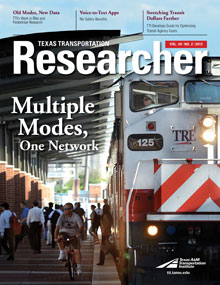The economy has recently shown signs of recovery, with some state budgets even boasting a surplus. Despite this good news, every sector of transportation must still do more with less. This is especially true of rural and small-urban transit agencies, which are seeing increased demand for their services even as their budgets are facing new restrictions.
To stretch their own budgets, individual drivers are relying more on transit to gain access to jobs, education, services, health care and recreation. Others rely on transit because they have to. For example, individuals aged 65 and older are increasingly living in rural areas. They need access to basic services, like medical care, which are often available only in more urban settings.

Texas A&M Transportation Institute (TTI) researchers recently completed Texas Department of Transportation (TxDOT) Project 0-6694 to help rural and small-urban public transit agencies better manage agency funds. By following recommendations presented in Guidebook: Managing Operating Costs for Rural and Small Urban Public Transit Systems, transit agencies can optimize their budgets, outsource where feasible, and provide their consumers the best transit services limited funding can buy.
“Our guide covers all aspects of operational management,” explains TTI Associate Research Scientist Suzie Edrington, principal author of the guidebook. “From explaining fundamental cost-control principles to managing personnel to handling fuel purchases and choosing external contractors, we present best practices that agencies can use to better manage their resources.”
The guide is divided into three parts:
- fundamental concepts, definitions and formulas necessary for understanding and capturing agency costs;
- strategies for optimizing transit costs across all agency operational areas; and
- tools and resources to support agencies as they perform cost analyses.
Throughout the guide, authors use the fictional Anytown Transit Agency to demonstrate core concepts from budgeting and cost analysis to options for handling fuel storage and maintenance. Anecdotes from actual agencies flesh out the fictional examples depicted in Anytown.
The guide also addresses non-traditional but important topics, such as making maintenance procedures more efficient or working with drivers to help the agency reduce fuel consumption. Edrington explains: “Transit agencies can cut fuel costs as much as 10 percent if drivers monitor their behaviors, and that can be a significant cost factor, especially over time.”
Call-outs emphasizing important concepts, “lessons learned” boxes detailing actual agency experiences, and chapter summaries are some of the design elements specifically aimed at reinforcing retention of the information presented.
“TTI did a thorough job researching lessons learned from transit agencies around Texas,” says Kelly Kirkland with TxDOT’s Public Transportation Division. “In fact, transit agency personnel of varying experience levels recently attended a pilot workshop, and all were able to better evaluate various operating cost management practices by implementing its recommendations.”

